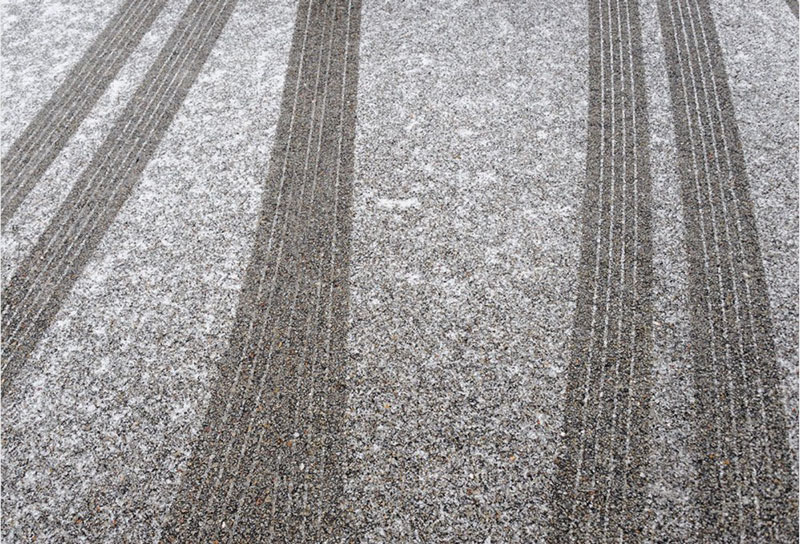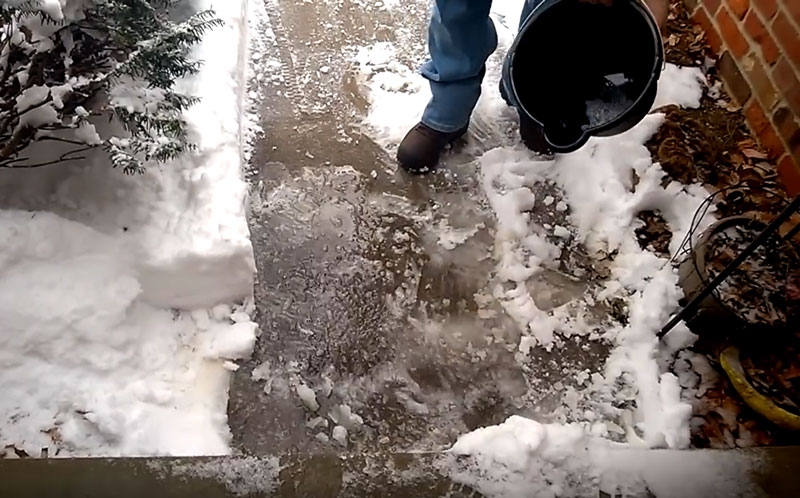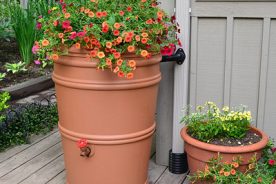Winter is inevitable in the northern part of the country and many of us are used to dealing with all the undesirable circumstances it has to offer – cold temperatures, rough driving conditions, snow, and sometimes ice. Typically, after a snowstorm, snow can simply be removed with some good old shoveling or a snow blower. It’s the ice on our roads, driveways and sidewalks that poses the biggest problem.
If you are the Department of Transportation the most common way to battle icy, slick conditions on the road is with a chemical deicer, rock salt, or a combination of the two. While this is great for the city streets and highways it isn’t always the best option for residential use.
Why Not Salt?
Using salt or chemical deicers poses several problems for your driveway, sidewalk and front yard. It can wreak havoc on your driveway by damaging the concrete. Salt that spills over into the grass or landscaping can damage plants or leach into water supplies. For households with pets, these deicers can attract pets and be hazardous to their health or even burn the bottoms of their paws if they spend too much time outside.
So, What’s the Solution?
The best solution is to do what you can to avoid ice build-up on your drive and sidewalk. While this unavoidable in the case of an ice storm, ice from melting and refreezing is avoidable by making sure to shovel or blow the snow from walkways and driveways as soon as possible. It is also important to remove the snow before driving over it as this packs it down making it nearly impossible to shovel. For south-facing driveways, homeowners can use the sun to their advantage by allowing the sun to melt icy patches and then sweeping or scraping them off before refreezing occurs.
If none of these preventative solutions work, or in the case of that unavoidable ice storm, here are a few chemical free ways to remove ice from your driveway or sidewalk.
Hot Water
While pouring water on top of frozen water seems a bit counterproductive it can be a very effective and natural way to rid your pavement of slippery spots. This method is definitely recommended more for patches of ice as opposed to an entire driveway covered in ice. Simply boil some water and then pour the hot water over the icy place. Before the water had a chance to refreeze remove the melted ice and excess water with a shovel, ice pick, or driveway broom. It is a good idea to use this method during the warmest, and if the weather is right, sunniest part of the day so ice has less of a chance of reforming too quickly.
Saltwater or Pickle Juice
This method of chemical free deicing is best used in a pinch or when you are in a big hurry. It is also recommended for small areas of ice or even for your windshield or frozen door handle. All you need to do is mix some type of salt- rock salt, table salt, sea salt, whatever you have available really- with some warm water. In an even quicker pinch, it is possible to simply pour some pickle juice on an ice-covered windshield or icy patch. The high content of salt in pickle juice acts as an ice melt.
Mixing it in a spray bottle will allow you to spray the solution directly on the icy patch or your windshield for a quick way to melt thin spots of ice away. Again, it is important to use your windshield wipers, a scraper, a shovel or even a towel to get rid of the excess water and salt water before the slush and water refreezes again.
Homemade Ice Melt
Another chemical free option for getting rid of ice is a homemade ice melt. This concoction can easily be made using ingredients that most people have on readily on hand under their sink. The most common homemade ice melt is a two-to-one mixture of water and rubbing alcohol. The following recipe is also a common one:
- ½ gallon of hot water
- ¼ cup of rubbing alcohol
- 6 drops of dish soap
- Combine all ingredients in a bucket
Why does it work? Rubbing alcohol has a freezing temperature that is much lower than that of water. This helps the hot water speed up the melting process making the ice bubble up, melt, and be easily scraped away.
Once you’ve mixed your chemical free deicer you can pour it over the ice on your walk or driveway or pour some into a spray bottle for use on your car windows and door handles. This process is much safer for use on cars as there is no harmful chemicals or salt to damage paint.
Natural Non-Slip Materials
For a really organic alternative to chemical deicers and salt for your driveway and walkway, there are lots of natural materials that are easy to use, cost efficient, and won’t cause any damage to concrete, pets, or vegetation.
Consider using household items such as sand, wood shavings, bird seed, or sawdust. While these materials will not actually melt the ice they provide traction and work as an anti-slip agent. Many of them will also simply wash away as the snow melts or during the next rainfall without causing any harm to the environment or water sources.
Some people also like to use ashes or kitty litter for their gritty, non-slip properties. However, these have proven to cause cleanliness problems as the snow melts and they stick to the bottoms of shoes and pets’ feet.
Snow Melting Mat
Not sure you want to use any liquids or other materials on your ice patches? Maybe you just want to make the ice disappear. What you need is a snow or ice melting mat. Place one mat in front of your front door or a series of them down a walkway, stairs, or portion of your driveway. You will never have to shovel or deal with icy patches in these areas again.
Designed with a heating element placed between two layers of non-slip rubber, you can place a snow melting mat anywhere snow or ice accumulation is a problem. Simply plug the mat in and it will melt snow at a rate of 2 inches per hour. The melted snow is then evaporated off the mat leaving you with a clean, non-slick surface. While this is a more costly option than some of the other chemical free choices, it is definitely a hassle-free one.
Heated Driveway
While we wouldn’t advise heading out today and tearing up a perfectly fine concrete, one extremely effective way to get rid of ice is a heated driveway. Heated driveways are a luxury that allow homeowners the ability to never have to shovel, snow blow, or de-ice the space in front of their garage ever again. They are friendly to the environment in the fact that no chemicals are needed that could harm plants, animals or water sources. However, they can be expensive in the amount of electricity they use.
There is the option between hydronic systems and electric-coil systems when installing a heated driveway. Both are effective but installation will depend on the size of your driveway and the extent of your budget. They are a great consideration if you live in areas that receive a lot of winter snowfall and are best installed when pouring a new driveway or replacing a deteriorating one. Installation and electricity costs will vary depending on location but can cost into the thousands of dollars range.
These are just a few of the options to consider when it comes to getting rid of the ice on your driveway and sidewalk using a safer, chemical-free method. Whether you’re looking for something more cost effective, safer for the environment, or just a quick fix, find something that will fit into your lifestyle and budget.










No Comments